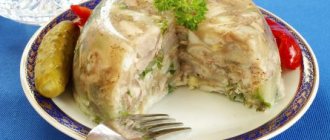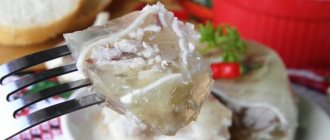When jelly and jellied meat appear on a menu or cookbook, the question naturally arises as to how these two dishes differ. Without going into details, we can say that these are two identical dishes with different names. But in fact, there are quite a lot of differences between them, both in the composition of the ingredients and in the cooking technology.
What is jelly
Jelly is a jelly-like dish thickened in the cold from boiled meat and the broth in which it was cooked. To prepare the dish according to an authentic recipe, be sure to take beef or veal head and legs so that the jelly sets and does not spread, and also has a deep, interesting taste.
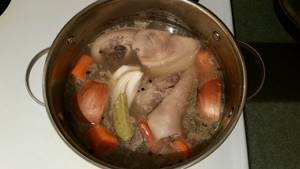
The ingredients for the jelly should be cooked for at least 8 hours.
Jelly in its unchanged form is better known in the northern regions of Russia, where it is prepared according to the cookbooks of the USSR, and always eaten with horseradish. This dish has long been respected by representatives of professions who spend all day outside: hunters, shepherds, fishermen. They can take the jelly with them and consume it either cold or heated over a fire.
Differences in product range
One of the most important differences between jellied meat and jelly is the ingredients from which they are traditionally prepared.
- For jellied meat, not only beef is used, but also pork and poultry. As a rule, to obtain a strong, rich broth, parts of animals that are of little use for food and are rich in gelatin are used. Usually these are legs, shanks, ears, brain bones. They contain a large amount of cartilage, which is responsible for turning the broth into jelly.
- Subsequently, pulp (both pork and beef), as well as poultry, preferably turkey or rooster, are added to the broth being prepared.
- In addition to this, the use of spices in jellied meat is mandatory. Usually this is bay leaf, allspice, carrots and other additives to taste. This variability allows you to get slightly different tastes of the finished dish each time.
Jelly is always cooked only from beef; adding other types of meat is unacceptable. Ears, heads and tails, and drumsticks are often used to prepare this dish. Of the spices, it is permissible to use only garlic.
What is aspic
Jellied meat is a composite dish of meat or poultry, as well as the broth in which they were cooked, with the obligatory addition of spices and vegetables. It is kept in the cold until it completely hardens in the form of jelly. In order for the process to be guaranteed to occur, the recipe calls for preparing the dish mainly from legs, ears, heads, tails - parts of the carcass containing a maximum of gelling substances.
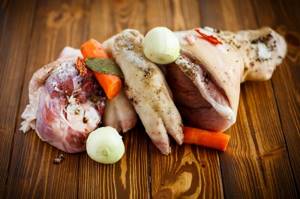
Meat, vegetables and spices for preparing jellied meat can be selected according to your taste
Jellied meat is common in the southern and southeastern regions of Russia, Belarus and Ukraine. In various national cuisines, there are analogues that differ slightly in recipes, spices used and types of meat. For example, in Georgia it is muzhuzhi, in Moldova it is rooster jelly, in Bulgaria it is pacha.
Table
| Aspic | Jellied |
| It is considered an original Russian dish, known since time immemorial. | It is a variation of the French galantine, which arose in Rus' only in the 19th century. |
| The preparation is based exclusively on meat products, which give a thick broth. | The main ingredients used are fish, poultry and beef fillets. |
| Filled with well-cooked meat broth | Jelly is formed from water or broth mixed with gelatin |
| After drying it turns out cloudy | Thanks to the completely transparent filling, all ingredients are clearly visible |
| Does not involve the use of various additives | Bright vegetables, peas, corn, eggs, herbs, etc. are used for decoration. |
| The filling has a rich taste | The jelly turns out bland |
| Is a complete and very satisfying dish | Serves as a snack without much nutritional value |
Jelly and jellied meat: general points
There are far more similarities in the preparation of jelly and jellied meat than there are differences. This is not surprising, since both dishes are essentially thickened boiled meat in its own broth.
What do jelly and jellied meat have in common:
- the meat for both dishes is cooked at a low boil or on the verge of boiling, with the lid open or slightly open;
- It is periodically necessary to remove foam and fat from the surface of the broth using a slotted spoon, but without stirring the main mass;
- It is customary to salt the broth for both jelly and jellied meat immediately before the end of cooking, or after removing the dishes from the heat;
- water must be poured in advance in the required quantity so that it does not need to be topped up, which will negatively affect the gelling properties;
- Both dishes mainly contain offal - legs, heads, tails, ears and similar not very valuable parts of the carcass;
- It is preferable to take fresh or chilled ingredients, since the use of frozen bones negatively affects the transparency of the food.
What is the difference between these dishes?
These two dishes differ from each other not only in the method of cooking and the meat products from which they are prepared. These dishes have completely different tastes , and they also differ in appearance. Jellied meat, due to the fact that it is prepared from several different types of meat, is much lighter and denser than jelly. Jelly-like jelly is softer in taste and appearance, and due to the beef it is darker.
- Jellied meat is prepared from several types of meat, and its bases are pork bones, pork and poultry pulp. The basis of the jelly is the bones of the legs, tail and head, and the meat it contains is exclusively beef.
- Jellied meat is cooked by adding meat to it in several stages. And when cooking jelly, all the ingredients are placed in the pan at the same time.
- The jelly broth needs to be clarified before pouring into molds. And the broth for jellied meat is simply filtered.
- For the jellied meat to harden, it is enough to boil it for no more than ¼ day. But the jelly has to be cooked longer, otherwise it will not harden.
- Various spices, roots, and herbs are always added to jellied meat for taste, but only garlic is added to jelly.
Classic jelly recipe
The jelly takes a long time to prepare, but the result is worth it. The main thing for everything to work out is to strictly follow the recipe.
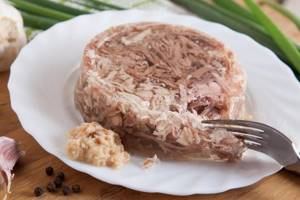
Classic beef jelly
Ingredients:
- beef head and 4 shanks;
- onions – 2 pcs.;
- parsley root - to taste;
- bay leaf – 3 pcs.;
- garlic – 1 pc.;
- black peppercorns - to taste;
- salt - to taste;
- vinegar – 1 tsp.
We scorch the beef offal, chop it into small pieces and soak in clean chilled water for a couple of hours. We rinse them thoroughly, clean them if necessary, put them in a large container - a saucepan or basin, based on the fact that you need to fill everything with water, a volume twice as large as the meat itself. We also put onions, garlic, parsley, bay and pepper there. Cook everything for about 8 hours over low heat, promptly removing any foam that appears. We take out the beef, separate the meat and chop it finely, and send the bones back into the broth to cook for another couple of hours.
After the broth has evaporated to such an extent that it becomes approximately the same volume as the meat, add some salt and vinegar, quickly bring to a boil and turn off the heat. Separate the liquid from the rest of the mass and filter so that the jelly is transparent, without solid particles.
Place the meat in low ramekins or a large bowl and pour the broth evenly. Let it harden in the refrigerator or, in the cold season, outside. Serve with horseradish and mustard.
How to prepare jellied meat
Jellied meat is a meat snack cooked in strong bone broth. Due to the large amount of bone broth, the dish turns out jelly-like, and even at room temperature it retains this shape. Jellied meat is loved for its rich meaty taste. And the unique aroma of this dish is obtained due to various seasonings and spices added to the meat broth during cooking.
This dish is usually served cold; it is usually accompanied by spicy seasonings - mustard, horseradish, etc. It is served along with appetizers before the first or second courses.
Usually, first they cook pork legs, a moto, and part of a pig's head. After boiling, after about 50 - 60 minutes, add pieces of beef with bones and chicken carcass. Due to the fact that several different types of meat are used when cooking jellied meat, the unique aroma of this dish is created.
Usually jellied meat is cooked over low heat for about ¼ day. About 50 - 60 minutes before the end of cooking, add parsley roots, dill, garlic, onions, carrots, bay leaves, black peppercorns, salt and other spices to taste.
After cooking, the broth must be strained (through a colander or gauze folded in several layers). The meat must be removed from the bones, cut into small cubes and placed in special deep molds about 2/3 full and filled with strained broth. You need to cool the jellied meat in a cool place, preferably in a draft.
Classic jellied meat recipe
Jellied meat allows the housewife to use her imagination when preparing, replacing types of meat, spices and vegetables to her taste. Therefore, each time the dish will be slightly different from the previous version.
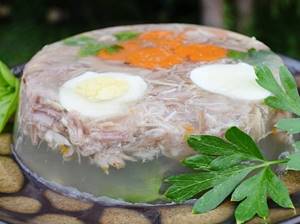
Jellied meat with carrots and boiled eggs
Ingredients:
- pork leg – 1 pc.;
- beef shoulder – 0.5 kg;
- carrots – 2 pcs.;
- onions – 2 pcs.;
- bay leaf – 3 pcs.;
- garlic – 1 pc.;
- parsley root – 50 g;
- black peppercorns – 10 pcs.;
- salt - to taste.
We wash the meat, if necessary, then additionally clean it of bristles and other things, put it in a saucepan, and add onions, onion peels, peeled carrots, and parsley roots. In this case, onion peels are used to give the broth a beautiful, slightly golden color. If you want it to be transparent or close to it, then we throw out the husk.
Fill the prepared products with water 3-5 cm above their level, bring to a boil, then reduce the heat and cook at the brink of boiling for 6 hours. An hour before cooking, add pepper and bay leaf.
At the end of cooking, strain the broth, for example, through gauze folded several times, to prevent the ingress of boiled seasonings and debris, as well as to ensure the most transparent consistency. Separate the meat from the bones, separate it into fibers and cut into small pieces. Chop the garlic and mix with the meat; add chopped boiled carrots if desired.
We transfer the prepared products into molds or into one large form. Salt the broth, pour it over the meat and vegetables. Let it stand for half an hour at room temperature and send it to finally harden in the refrigerator for 8-12 hours.
What is the difference between jelly and jellied meat
Jellied meat is considered one of the masterpieces of Russian traditional cuisine. It is prepared in most families for the New Year's table and served in restaurants. There are more than enough options for this dish. Often in recipes and menus you can find such varieties as jelly and aspic. What is the difference between jelly and jellied meat?
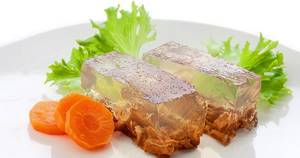
Despite the fact that jellied meat is called an original Russian dish, its prototype is considered to be French galantine, prepared from rich chicken, veal or rabbit broth with the addition of spices and eggs. Galantine was prepared from selected meat and served even at the royal court, while jellied meat was always a dish “for the poor.” Frozen meat broth is especially widespread in the northern regions. Nomads and hunters took it with them to heat it over a fire and enjoy hot, fatty soup.
Jellied meat is one of the healthy dishes. It contains a large amount of collagen and natural gelatin. These substances maintain the density of bone and cartilage tissue in the body, slow down aging, and improve joint mobility. In addition, jellied meat contains B vitamins, which strengthen the body’s resistance to viruses. However, due to its high calorie content, excessive consumption of jellied meat can negatively affect cholesterol levels and add extra pounds.
The name “studen” is typical for the northern and northwestern regions of Russia. Today it is believed that jellied meat and jelly are different names for the same dish. However, culinary history researchers claim that jelly is prepared exclusively with beef broth, and jellied meat with pork or poultry broth. By the way, “aspic” is mainly prepared with fish broth.
The second difference is the technology for preparing these dishes. Jellied meat is cooked in three stages. At the first stage, pig ears, bones, legs, etc. are laid. Then poultry meat is added, and an hour before readiness, seasonings, herbs, carrots, etc. are used. The jelly is prepared in one stage: all the ingredients are added at once.
Due to the use of light meat, the broth for jellied meat has an appetizing golden appearance. It is filtered and left to harden. Jelly cooked with beef must be clarified with beaten egg whites and lemon juice.
The cooking time also differs. Beef requires up to twelve hours to fully cook, while pork takes no more than six hours to cook.
Conclusions:
- Jelly is prepared exclusively with beef broth, and jellied meat with pork or poultry broth.
- Jellied meat is cooked in three stages, jelly in one.
- Jellied meat is cooked for about six hours, jelly for up to twelve.
- Jellied meat, unlike jelly, does not need to be clarified.
A little about the beneficial properties of these dishes
Why are these dishes so healthy? It turns out that in jellied meat, during the cooking process, collagen - a substance necessary for the normal growth of cartilage tissue and to strengthen bone tissue. This substance slows down the aging process of body tissues. Gelatin, extracted from the bones of the pig's head and legs, helps restore joints and promotes their mobility.
Due to the aminoacetic acid included in this dish, brain function improves, depression goes away, and also relieves hangover.
However, both of these dishes are very high in calories, so overweight people should not eat them in large quantities. Also, these dishes contain a sufficient amount of “bad” cholesterol. The abundance of spices that are added to jellied meat overloads the liver and blood vessels.
Jelly, which is cooked only from beef, contains a large amount of the so-called “growth hormone”, so eating this dish in large quantities can cause inflammatory processes and excessive tissue swelling.
It is not recommended for preschool children to include this dish in their diet - such food is quite heavy for their digestive system.
There are various recipes for making jellied meat and jelly, differing in the amount of ingredients, herbs and spices. But the basic principles of preparing these dishes remain unchanged.
